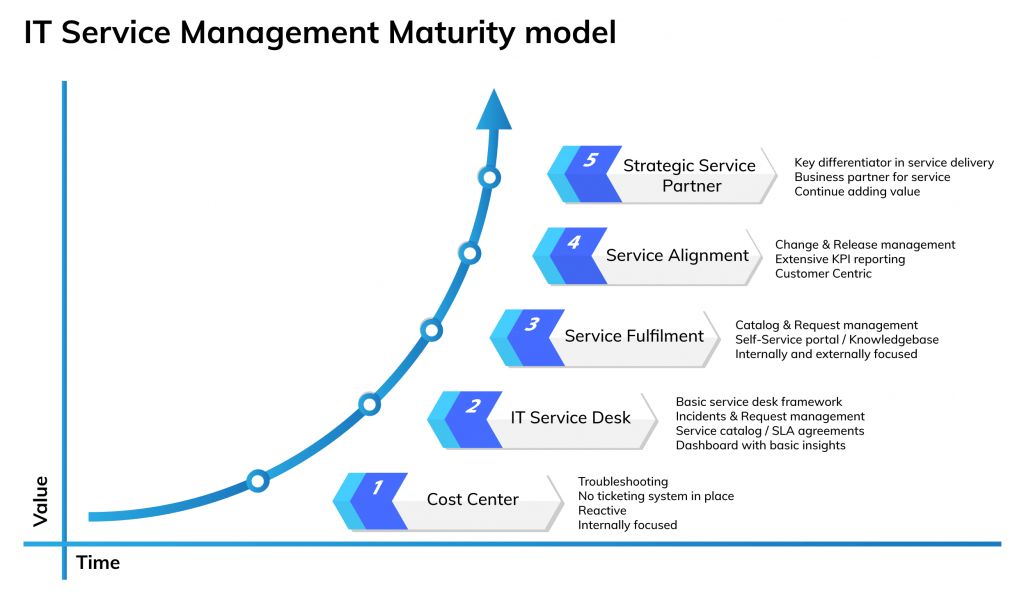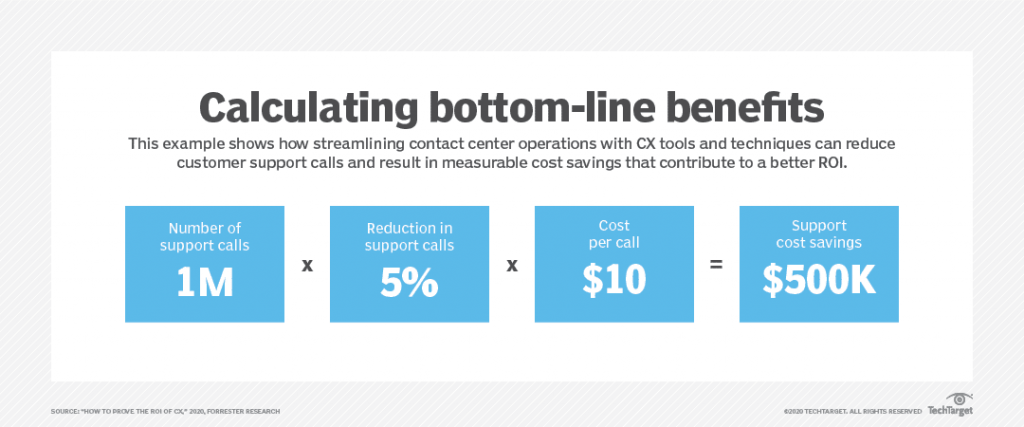In my last article I discussed the concept of the Maturity model for setting and progressing your IT Service Management approach.
If you missed it, have a look and here’s a visual reminder of the curve:

In this article I am starting at the beginning, like any good story; because if your service company has a good foundation it is a more fluent and easy progression of improvement.
So, let’s look deeper at the behaviors of an organization at this phase and how they can start to adjust in order to bring better experiences to customers and employees; cost-effectively and with ROI…
ITSM Maturity Level 1: Cost Center (or foundation level where your business is not yet deriving true ROI from the service operation)
More and more organizations see the importance of introducing a Customer Service application in order to overcome an undocumented and disconnected service management “process”. Service teams in this stage are often working in siloes, with customer information held separately and using processes that do not work together. The service here is fractured, reactive and unproductive, leading to repeated issues and a frustrated customer/agent experience.
By improving and professionalizing Customer Service as a major lever to improve Customer Experience, organizations can gain trust and invest in a long term relationship with customers and employees.
Starting with a best-in-class service platform with focus
Centralizing and structuring information is key best practice in this phase, with all service oriented teams moving towards using the same technology, data sets and processes.
By switching separate legacy tech that isn’t connected into one CRM made for customers (such as Microsoft Dynamics 365 Customer Service) your employees and customers start to benefit from structure.
In my experience with some of my clients and prospects, who are in this maturity stage, it can sometimes be overwhelming to make the leap “from zero to hero” which is why we have developed an implementation service called Jump Start and a solution called Fast Service.
Without the need for specific technical skills and high overheads in manpower and IT, it’s a simplified and focused way to configure Dynamics 365 Customer Service, to structure the process of incoming tickets, queues for specific topics, supporting the main channels of e-mail and phone to bring added value in not more than 6 weeks.
It’s all about starting with the basics, getting your teams used to more streamlined processes – in order to see better user adoption, one way of working, in order to move forward with ease.
Benefits of a Jump Start Fast Service approach:
- Get up and running quickly
- Improve customer case resolution and boost agent productivity
- Empower the modern Customer Service agent
- Inform your decision-making and speed up your service provision with out-of-the-box dashboards
So, this has addressed the problem of “siloes” and “reactivity” we discussed as key behaviors in Stage 1. What else can your business be doing in order to progress the curve?
Moving away from internally-focused service operation – start with feedback collection
Feedback of customers and employees often refers to the process of acquiring an opinion about the organization, product, or service.
The key with collecting feedback is to ask the right questions at the right time.
Whatever your size, complexity or sector, there are many feedback management solutions on the market which are easy to implement. Two such examples that I often propose, depending on my client’s needs are Microsoft Dynamics 365 Customer Voice and Howazit.
Customer Voice is a feedback management solution that helps you capture customer feedback directly from surveys personalized for your audience, the beauty of it is that its scaleable (start with templates) and you can also connect feedback with customer information in other business applications such as Microsoft Dynamics 365 Customer Service for richer insight.
Howazit is also integrated with your customer service app, and I like the modern approach of collecting bite-size amounts of feedback at each key touchpoint in order to build up insight and create actions as the customer journey progresses. It’s a fun, modern and user-friendly platform, that rather than wait for a long form survey, feedback is requested via a Chat-bot style experience, less onerous for the customer. Industry surveys have reported that support calls can be reduced by 50% by using more modern methods such as Chat. Take a look at this handy article for calculating your own cost-per-call.

Turning data into insight with categories for prioritization of service issues
By using structure in your case management processes with rules for queues and case assignment or using designated e-mail addresses; you can align support calls from employees or customers to specific agents or teams or based on type of questions (delivery, maintenance, hardware, etc.). If you do that in parallel to requesting feedback on the service received, it will be a much easier way to spot trends and focus on where you need to make improvements.
Whilst there are great feedback collection and management tools on the market, it is worth a quick word on how you prepare your feedback strategy in order to get the best insight from it.
It’s advisable to categorize the questions in the same way as your case management structures so you can structure and scale the support. By theming and structuring your feedback requests it will provide you insights about the value of customer service, what topics are top of mind at customers and where to start improving the customer experience. It is vital to do this in order to move forward in the IT Service Management maturity curve.
Step up to the basics of ITSM
In preparation to move toward step 2 of the maturity level it’s important to gather and address insights specifically about how your business handles or your customers need from incident management, request management and service catalog.
Now that we have covered the basics of turning your service operation into a more structured and outward looking organization, in my next article I will address how we expand that and look at how ITSM best practice can be implemented at your organization.
Article initially published on LinkedIn






